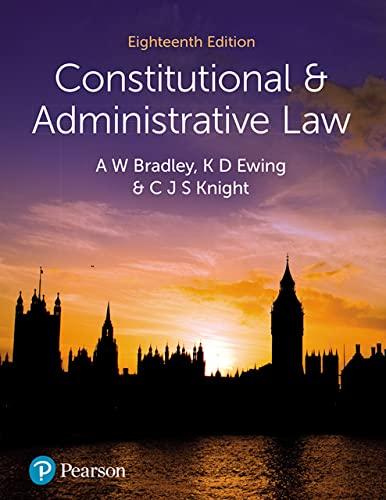Question
Question 1 Critically read Rushbond Plc v The J S Design Partnership LLP [2020] EWHC 1982 (TCC) and answer the following questions: 1. What were
Question 1 Critically read Rushbond Plc v The J S Design Partnership LLP [2020] EWHC 1982 (TCC) and answer the following questions: 1. What were the facts of the case? 2. What was the negligent omission in this case? 3. What arguments were forwarded by both parties (Plaintiff & Defendant) in this case? 4. explain the concept of 'pure omissions'. Does a 'pure omission' attribute liability on the wrongdoer? Note: The above case was successfully appealed - see decision and reasoning in Rushbond Plc v The JS Design Partnership LLP [2021] EWCA Civ 1889. Students must read this case in their own time in order to successfully answer the scenario below. Question 2 Mr. Kim owned an automotive garage located in an industrial area. His garage specialised in vintage vehicle restorations. In April 2022, Mr. Kim realised that his garage's annual cyclone insurance was shortly due. Before the insurance could be renewed, the insurance company required an engineers' inspection of the garage. Mr. Kim usually relied on the property manager, Mr. Ram, to facilitate the required inspections. Mr. Ram kept Engineers PTY (a local engineering firm) on a yearly retainer to complete inspections and prepare reports for insurance purposes. However, on the inspection date, Mr. Ram's daughter fell ill and needed to be taken to the hospital. Mr. Ram instructed the engineers from Engineers PTY to pick up the keys from his home, inspect the garage and then return the keys to him once they finished. Mr. Ram gave the engineers the alarm code for the garage. The engineers did as they were instructed: around 5:00 PM that day, they collected the keys, made the inspection and returned the keys to Mr. Ram. Later that evening, Mr. Kim received several calls from friends advising him that his garage was on fire. Distraught, Mr. Kim arrived at the scene to see his life's work in flames. All of the vintage cars in the garage were also destroyed. This amounted to an estimated loss of about $3,000,000. Investigations concluded a week after the fire. The fire investigators found that the garage fire was due to arson. The arsonists had used an accelerant to engulf the garage in flames. The CCTV footage from an adjacent property revealed that the arsonists had entered the property while the engineers were conducting the inspection of the internal rood purlins for structural integrity. The engineers had left the door unlocked while they were conducting the inspection; this was the door that the arsonists used to enter the property. It was unclear how the arsonists evaded the alarm sensors after the engineers had left nor why they set the garage on fire. Mr. Kim has approached you for advice on possible actions that can be taken against Engineers
Step by Step Solution
There are 3 Steps involved in it
Step: 1

Get Instant Access to Expert-Tailored Solutions
See step-by-step solutions with expert insights and AI powered tools for academic success
Step: 2

Step: 3

Ace Your Homework with AI
Get the answers you need in no time with our AI-driven, step-by-step assistance
Get Started


